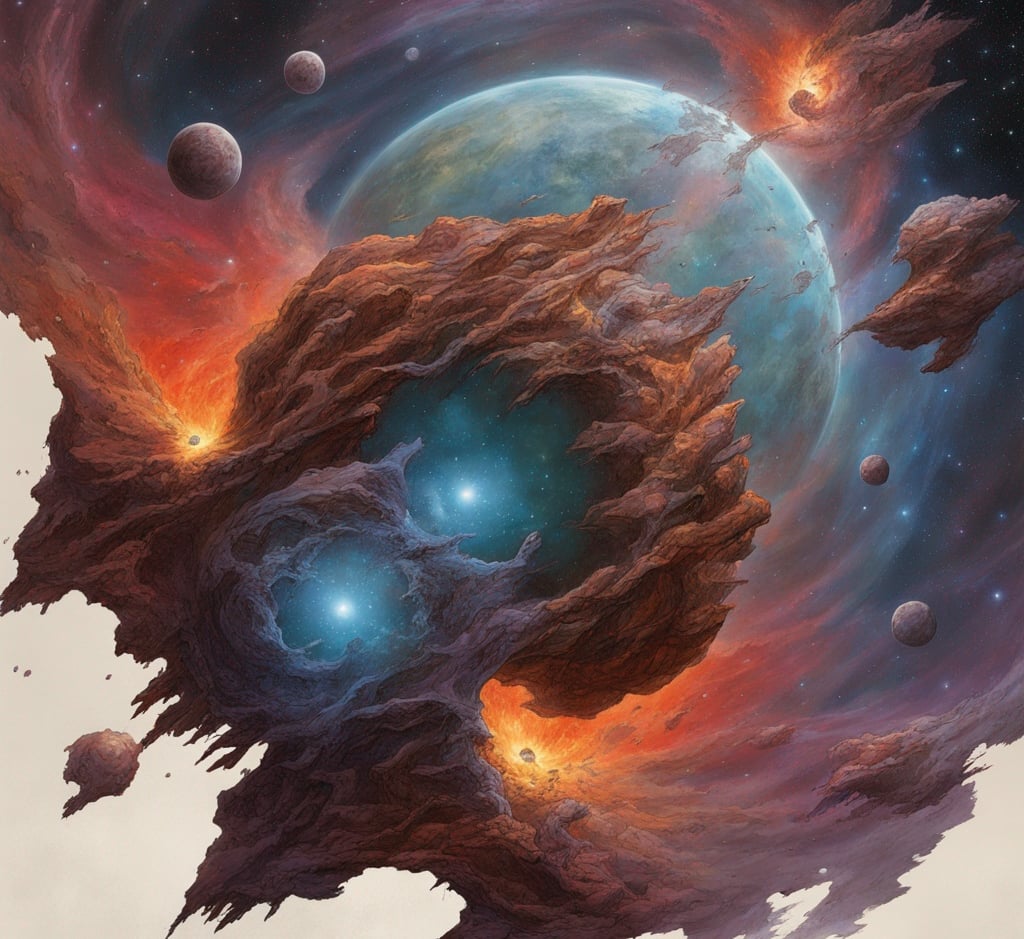Cosmic Whispers
Tales from the Nebular Depths
SPACE
5/8/20259 min read


The Silent Guardians of the Void
In the vast expanse of space, nebulae stand as ancient sentinels, their luminous forms stretching across light-years, telling stories older than human civilization itself. These cosmic clouds of gas and dust are not merely celestial phenomena—they are the birthplaces of stars, the remnants of stellar deaths, and perhaps, the keepers of secrets we have yet to comprehend.
The Eagle Nebula, with its famous "Pillars of Creation," continues to captivate astronomers and dreamers alike. These towering columns of interstellar matter stretch several light-years high, nurturing new stars within their dusty embrace. Standing before images of these cosmic pillars, one cannot help but feel insignificant yet connected to something grand and eternal. Within these pillars, matter condenses, gravity pulls, and the miracle of stellar birth unfolds—a process that has continued uninterrupted for billions of years.
But what if these nebulae are more than they appear? What if, in their swirling patterns and luminous tendrils, they harbor stories beyond our current understanding?
The Whispering Veil of NGC-7293
The Helix Nebula, cataloged as NGC-7293, resembles a giant cosmic eye gazing into the depths of space. Located approximately 700 light-years away in the constellation Aquarius, this planetary nebula was formed when a dying star expelled its outer layers, creating the mesmerizing structure we observe today.
Dr. Elena Mikhailov of the Cosmochronology Institute has spent decades studying the unusual radio emissions emanating from the Helix. "The patterns we're detecting defy conventional explanation," she explains during a late-night observation session. "There's an almost rhythmic quality to them, as if the nebula itself is... communicating."
Her theory, while controversial among traditional astronomers, has gained traction among those studying astrobiology and SETI. The Helix's emissions, when mapped against standard background radiation, reveal structures too ordered to be dismissed as random cosmic noise. Some researchers have even suggested that the nebula may serve as a natural amplifier for signals originating from deeper within our galaxy.
"We're not saying it's artificial," Mikhailov clarifies, "but rather that natural processes might create conditions that preserve information across vast timescales. The nebula might be 'remembering' events from its formation—or even earlier."
The Mysterious Disappearance at Barnard 68
The dark nebula Barnard 68 appears as a void in space—a perfect cosmic shadow against the backdrop of distant stars. Unlike its more flamboyant counterparts, this dark cloud absorbs nearly all visible light, creating what appears to be a hole in the fabric of the night sky.
In 2019, a research expedition led by Dr. James Yamoto set out to study this dark nebula using specialized equipment designed to penetrate its opaque exterior. The seven-member team established a research station on Europa, Jupiter's icy moon, where atmospheric interference was minimal.
Their initial findings were promising. Using advanced infrared and radio astronomy techniques, they began mapping the interior structure of Barnard 68. Then, on the forty-seventh day of their mission, something unprecedented occurred. During a routine observation, the team's primary equipment detected what Dr. Yamoto described in his final transmission as "a structural impossibility."
Hours later, all communication with the Europa station ceased. When a rescue mission arrived three weeks later, they found the station intact but completely abandoned. The team's research data, equipment logs, and personal effects remained undisturbed. The only clue was a single handwritten note found in Dr. Yamoto's quarters: "It sees us watching."
The incident remains classified by international space agencies, though rumors persist among the astronomical community. Some suggest equipment malfunction led to hallucinations and subsequent evacuation, while others propose more fantastic theories involving spatial anomalies or even interdimensional phenomena.
The Oracle of Carina
The Carina Nebula spans over 300 light-years, its chaotic beauty housing some of the most massive and luminous stars known to humanity. Within this stellar nursery, astronomers have identified an unusual region dubbed "The Oracle."
This section of the nebula exhibits peculiar properties that have puzzled scientists since its discovery. Radio waves passing through The Oracle emerge with subtle but measurable alterations. More strangely, these alterations appear to correlate with significant astronomical events elsewhere in our galaxy—often preceding them by hours or even days.
In 2023, an international collaboration of observatories noted that The Oracle's emissions shifted dramatically twelve hours before a distant supernova became visible from Earth. Statistical analysis has ruled out coincidence with 99.97% certainty.
"It's as if this region of the nebula somehow 'knows' what's about to happen elsewhere," explains astrophysicist Dr. Sanjay Mehra. "We're investigating whether unique plasma conditions might create a kind of natural gravitational lens that detects ripples in spacetime before they're otherwise observable."
Others have proposed more radical theories. Dr. Laurence Wei of the Quantum Cosmology Institute suggests The Oracle may represent a natural manifestation of quantum entanglement on a cosmic scale. "What we're witnessing could be evidence that certain regions of space retain quantum connections across vast distances," he proposed at a recent conference. "The implications for our understanding of reality would be profound."
The Ghost Ships of the Horsehead Nebula
The Horsehead Nebula in Orion has long been one of astronomy's most recognizable features—a dark cloud of dust and gas silhouetted against the glowing background of IC 434. Less well-known are the transient phenomena that observers have reported in its vicinity.
Since the early 2000s, long-exposure photography has occasionally captured what appear to be organized formations of light moving through and around the nebula. These "ghost ships," as they've been informally dubbed, leave no permanent trace and cannot be tracked by conventional means.
Astronomer Isabelle Cortez first documented these formations in 2007. "They appear as faint geometrical arrangements of light—often triangular or rectangular—that move in non-random patterns," she wrote. "They're visible only in exposures lasting between eighteen and twenty-four minutes, suggesting they operate at a very specific frequency of light emission."
Skeptics maintain that the phenomena result from camera artifacts or atmospheric distortion. However, the simultaneous observation of identical formations from different locations on Earth has weakened this explanation.
In 2022, the James Webb Space Telescope captured the most detailed images yet of these formations. Analysis revealed structures consistent with massive objects utilizing the nebula's magnetic fields for propulsion—a technology theoretically possible but far beyond our current capabilities.
"We're not claiming these are artificial spacecraft," clarifies Dr. Hiroshi Nakamura of the JWST analysis team. "But these formations move against the prevailing forces in the nebula and maintain their structural integrity despite passing through turbulent regions. Whatever they are, they're not simply clouds of gas behaving normally."
The Memory of Stars: The Crab Nebula's Secret
The Crab Nebula, remnant of a supernova observed by Earth's astronomers in 1054 CE, continues to expand at over 1,500 kilometers per second. At its heart lies a pulsar—a rapidly rotating neutron star that sweeps beams of radiation through space like a cosmic lighthouse.
Deep within the chaotic filaments of the Crab, astronomers have identified structures that appear to preserve information about the original star's death. These "memory filaments" contain isotopic signatures that should have been scattered by the explosion but instead remain organized in patterns that defy current astrophysical models.
"It's as if parts of the nebula remember what the star was like before it died," explains Dr. Maria Gonzalez. "We're discovering that supernovae don't completely destroy the information contained within the original star. Some of it gets encoded into the structure of the nebula itself."
This finding has implications beyond astronomy. Theoretical physicists have long debated whether information can truly be destroyed in our universe. The preservation of stellar information within nebular structures suggests a universe that never truly forgets—where history is written not just in light traveling across space but in the very structure of matter itself.
The Boötes Void: The Nothing That Shouldn't Be
Perhaps the most unsettling cosmic mystery lies not in what we can see, but in what we cannot. The Boötes Void is an enormous spherical region of space, approximately 330 million light-years in diameter, that contains almost nothing. Where there should be thousands of galaxies, we find only a handful, as if something has swept this region of space clean.
The perfect spherical shape of the void defies explanation by standard models of cosmic evolution. Computer simulations suggest that natural processes would create irregular, elongated empty regions—not the perfect sphere of emptiness we observe.
Some astronomers have reluctantly considered the possibility that the void represents evidence of actions by an advanced civilization—one capable of engineering space on a galactic scale. Others propose more exotic explanations involving alterations to the fundamental constants of physics within the void.
"Whatever created the Boötes Void would require energy on a scale that's difficult to comprehend," notes cosmologist Dr. Alan Weinberg. "We're talking about the equivalent of millions of supernovae directed with extraordinary precision."
In 2024, a collaborative effort using radio telescopes across Earth and in lunar orbit detected faint signals from the void's center—regular pulses that repeat precisely every 42.8 hours. Analysis is ongoing, but preliminary findings suggest the signals contain structured information rather than random emissions.
The Living Clouds of IC-1396
The Elephant's Trunk Nebula within IC-1396 has recently become the focus of astrobiology research due to its unusual chemical signature. Spectroscopic analysis has revealed organic compounds organized in ways that mirror biological processes on Earth.
"We're detecting what appear to be self-replicating chemical structures within the nebula's outer regions," explains astrobiologist Dr. Sandra Okonjo. "These aren't life as we understand it, but they exhibit properties associated with living systems—they maintain their structure despite energy flowing through them, they replicate with variations, and they appear to evolve in response to radiation pressure."
The discovery has sparked debate about redefining life beyond our terrestrial understanding. If these chemical structures within the nebula are indeed engaging in a form of reproduction and evolution, they might represent a completely novel form of cosmic life—one based not on carbon and water, but on interstellar plasma and radiation.
"We may need to expand our conception of life," suggests Dr. Okonjo. "Perhaps consciousness itself exists on a spectrum that includes these vast nebular processes operating on timescales of millions of years."
The Signal from the Pleiades
The Pleiades star cluster, visible to the naked eye and revered by cultures throughout human history, holds a special place in our collective imagination. In 2021, this famous star cluster became even more significant when the FAST radio telescope in China detected an unusual signal emanating from its vicinity.
Unlike the random noise typically associated with natural cosmic phenomena, this signal contained prime numbers in sequence—a pattern long theorized to indicate intelligent origin. More puzzling still, the signal appeared to be responding to radio emissions from Earth, with a delay precisely matching the distance to the Pleiades.
"It's as if something there is listening and responding," notes SETI researcher Dr. Liu Wei. "Each response contains not just the patterns we send but additional information—mathematical constants and astronomical coordinates that point to other star systems."
The international scientific community remains divided on the signal's significance. Some argue for natural explanations involving unusual plasma physics, while others cautiously suggest we may be observing our first confirmed contact with non-Earth intelligence.
Perhaps most intriguing is the signal's consistent reference to a date approximately twelve years in our future. Whether this represents a prediction, a warning, or an invitation remains the subject of intense debate among those privileged to study these mysterious emissions.
Beyond the Veil: Cosmic Consciousness
As our instruments grow more sensitive and our understanding of physics deepens, we find ourselves confronting possibilities once relegated to science fiction. The nebulae that dot our night sky—those colorful clouds we've observed since the dawn of astronomy—may be more than beautiful stellar phenomena. They may be pages in a vast cosmic story, holding memories of events long past and hints of what is yet to come.
From the Whispering Veil of the Helix to the Oracle of Carina, from the Ghost Ships of the Horsehead to the living clouds of IC-1396, we are discovering that the universe is stranger and more wondrous than we ever imagined. The line between astronomy and philosophy grows increasingly blurred as we contemplate the possibility that consciousness itself may exist on scales far beyond human experience.
As we continue our journey of cosmic exploration, we must remain open to the possibility that the greatest mysteries of space are not simply matters of physics and chemistry, but questions about the fundamental nature of existence itself. The nebulae, with their silent beauty and ancient light, invite us to look deeper, to listen more carefully, and to wonder what other stories might be waiting among the stars.
Perhaps, as we gaze into these cosmic clouds, they are in their own way gazing back at us—participants in a grand conversation spanning billions of years and countless light-years. In that exchange lies the true frontier of space exploration: not just the discovery of new worlds, but new ways of being and knowing in our vast and mysterious universe.
Get in touch




